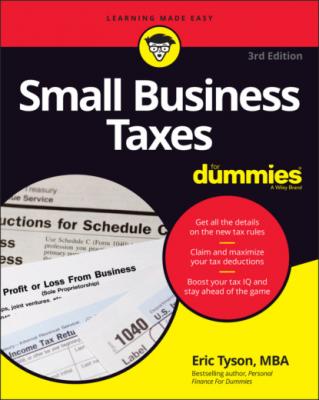Small Business Taxes For Dummies. Eric Tyson
Читать онлайн.| Название | Small Business Taxes For Dummies |
|---|---|
| Автор произведения | Eric Tyson |
| Жанр | Бухучет, налогообложение, аудит |
| Серия | |
| Издательство | Бухучет, налогообложение, аудит |
| Год выпуска | 0 |
| isbn | 9781119861164 |
So if the business shows a loss in some years, the owners/shareholders may claim those losses in the current year of the loss on their tax returns against other income earned. This is potentially useful in the early years of a new business, a time when most companies lose money. To be able to claim losses, you must “materially participate” in the business, which generally means that you actively work in the company at least 500 hours per year, although 100 hours will suffice if that’s the most among all other shareholders.
If, like most businesses, the company becomes profitable, it may actually make sense then to convert back to a regular C corporation to partake of the potential advantages of that status. That includes being able to retain earnings in the company, which you can’t do with an S corporation, and being able to use tax-advantaged fringe benefits. (If you plan to take all the profits out of the company, an S corporation may make sense for you.)
Even though the corporation doesn’t pay federal income tax, the company must annually complete and file IRS Form 1120S — “U.S. Income Tax Return for an S Corporation” (see the first page of the form in Figure 2-2; the complete form is located at www.irs.gov/pub/irs-pdf/f1120s.pdf). Also, some states levy a state income tax on S corporations, and many states require paying an annual fee.
Courtesy of the Internal Revenue Service
FIGURE 2-2: Page one of IRS Form 1120S, “U.S. Income Tax Return for an S Corporation.”
S corporation requirements
All corporations actually begin as so-called C corporations, which are the corporations discussed in the section “Deciding whether to incorporate” earlier in this chapter. To become an S corporation, your business must go through an additional “tax election” step. See IRS Form 2553, “Election by a Small Business Corporation.”
U.S. tax laws allow most, but not all, small businesses to be taxed as an S corporation. To be an S corporation in the eyes of the almighty IRS, a company must meet all the following requirements:
Be a U.S. company
Have just one class of stock
Have no more than 100 shareholders who are all U.S. residents or citizens and aren’t partnerships, other corporations, or, with certain exceptions, trusts
Partnerships
A partnership occurs in the eyes of the tax authorities when two or more people — the general partners (GPs) — operate a business together and divide the profits (or losses). The division need not be done equally.
The GPs are responsible for the company’s debts and liabilities. A partnership may also have limited partners (LPs) who generally provide financing to the business and who aren’t active in the company itself. Most small-business partnerships don’t have LPs.
A partnership is similar to a sole proprietorship and other pass-through entities for income tax purposes. Partners pay personal income taxes on their share of the partnership’s income distributed to them. This is done on IRS Form 1040 Schedule E, “Supplemental Income and Loss” (see the first page of the form in Figure 2-3; the complete form is available at www.irs.gov/pub/irs-pdf/f1040se.pdf). As sole proprietors do, partners pay self-employment taxes on income earned.
Courtesy of the Internal Revenue Service
FIGURE 2-3: Page one of IRS Form 1040 Schedule E, “Supplemental Income and Loss.”
Limited liability companies (LLCs)
In recent decades, a new type of corporation has appeared. Limited liability companies (LLCs) offer business owners benefits similar to those of S corporations and partnerships but are even better in some cases.
Like an S corporation, an LLC offers liability protection for the owners — hence the name limited liability company. In addition to the veil of overall liability protection for the owner’s personal finances, an owner’s liability for business debts is limited in an LLC to their percentage ownership share in the business.
LLCs also pass the business’s profits through to the owner’s personal income tax returns, like a sole proprietorship or partnership. You can pass through losses as well and deduct them against your other income so long as you materially participate in the business.
LLCs are generally much simpler to set up and administer than a corporation. But, to be realistic going into it, don’t expect an LLC to be as simple as a sole proprietorship. And LLCs don’t give you the ability to tap into some of the tax advantages (for example, specific fringe benefits) that some corporations offer.
LLCs have fewer restrictions regarding shareholders than S corporations. For example, LLCs have no limits on the number of shareholders, and the shareholders can be foreigners, corporations, or partnerships.
Compared with S corporations, the only additional restriction LLCs carry is that sole proprietors and professionals can’t always form LLCs (although some states allow this). All states now permit the formation of LLCs, but most state laws require you to have at least two partners for an LLC to be taxed as a partnership and not be a professional firm.
